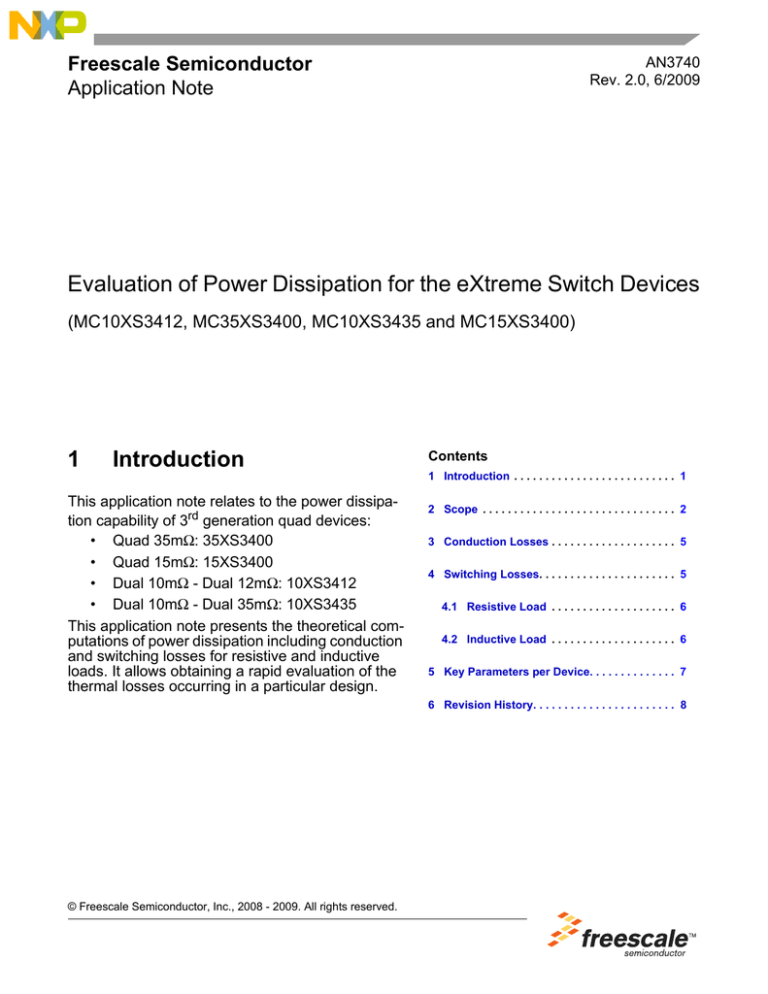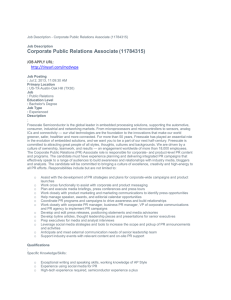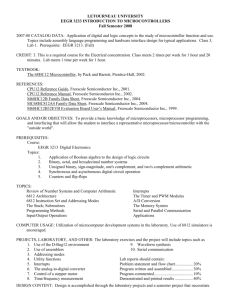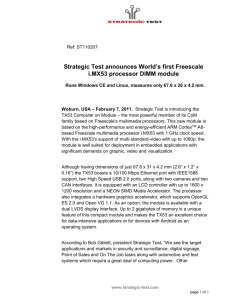
Freescale Semiconductor
Application Note
AN3740
Rev. 2.0, 6/2009
Evaluation of Power Dissipation for the eXtreme Switch Devices
(MC10XS3412, MC35XS3400, MC10XS3435 and MC15XS3400)
1
Introduction
This application note relates to the power dissipation capability of 3rd generation quad devices:
• Quad 35mΩ: 35XS3400
• Quad 15mΩ: 15XS3400
• Dual 10mΩ - Dual 12mΩ: 10XS3412
• Dual 10mΩ - Dual 35mΩ: 10XS3435
This application note presents the theoretical computations of power dissipation including conduction
and switching losses for resistive and inductive
loads. It allows obtaining a rapid evaluation of the
thermal losses occurring in a particular design.
Contents
1 Introduction . . . . . . . . . . . . . . . . . . . . . . . . . . 1
2 Scope . . . . . . . . . . . . . . . . . . . . . . . . . . . . . . . 2
3 Conduction Losses . . . . . . . . . . . . . . . . . . . . 5
4 Switching Losses. . . . . . . . . . . . . . . . . . . . . . 5
4.1 Resistive Load . . . . . . . . . . . . . . . . . . . . 6
4.2 Inductive Load . . . . . . . . . . . . . . . . . . . . 6
5 Key Parameters per Device. . . . . . . . . . . . . . 7
6 Revision History. . . . . . . . . . . . . . . . . . . . . . . 8
© Freescale Semiconductor, Inc., 2008 - 2009. All rights reserved.
Scope
2
Scope
This family of devices is designed for low-voltage automotive lighting applications. Its four low
RDS(ON) MOSFETs can control four separate 55W / 28W bulbs, and/or Xenon modules, and/or
LEDs, and/or other type of loads.
Programming, control, and diagnostics are accomplished using a 16-bit SPI interface. Its output
with selectable slew-rate allows to satisfy electromagnetic compatibility (EMC) requirements.
Additionally, each output can be controlled internal PWM modulated clock signal, instead of an
external clock.
This family of devices can drive currents in Amperes range, continuously or in PWM mode up to
1.0 kHz. At these current levels the power dissipation becomes a critical parameter. It is the
purpose of this application note to give analytical expressions for switching- and conduction
losses. This will allow the potential user to make a rapid evaluation of power dissipation of his/her
particular design, and can therefore help when dimensioning the cooling system.
Calculation of Power Dissipation , Rev. 2.0
Freescale Semiconductor
2
Scope
Figure 1 gives a typical application diagram using this type of quad high-sides device.
VDD
ignition
switch
VDD
10k
10k
VPWR
VDD
VPWR
VPWR
VDD
100nF
1uF
22nF
10µF
VDD
WAKE
I/O
FS
IN0
IN1
IN2
IN3
10k
I/O
MCU
10k
10k
10k
10k
SCLK
CS
I/O
SO
SI
A/D
HS0
MC10XS3412
SCLK
CS
RST
SI
SO
CSNS
FSI
100k
22nF
2.5k
22nF
LOAD 0
HS1
22nF
LOAD 1
HS2
22nF
LOAD 2
HS3
GND
LOAD 3
RFSI
VPWR
Watchdog
direct light commands (pedal, comodo, ...)
Figure 1. Typical Application Diagram
The losses occurring in each output, PDISS, consists of conduction losses (PON) and switching
losses (PSW):
PDISS = PON + PSW
•
•
Conduction losses PON occur when the device is fully ON.
Switching losses PSW occur during ON/OFF switching processes. The evaluation of
switching losses is not as simple as that of the conduction losses and must take into
account several factors such as output switching waveform, load type, battery voltage, …
Figure 2 shows a typical switching process for a resistive load with output voltage and current
waveforms (Vout, Iout), along with dissipated power (Pdiss). Power losses are divided in 3 parts:
ON switching losses (PSW_RISE), conduction losses (PON) and OFF switching losses
Calculation of Power Dissipation , Rev. 2.0
Freescale Semiconductor
3
Scope
(PSW_FALL). In this particular example, we can be noted that the switching losses are higher than
the conduction losses.
16
PSW_RISE
PSW_FALL
14
35
Vout
30
Iout
Pdiss
10
25
8
20
6
15
4
10
2
5
PON
0
0
200
400
600
P (W)
12
Vout (V), Iout (A)
40
800
1000
0
1200
t (µsec)
Figure 2. Power Dissipation Waveforms (Resistive load case for VPWR=14V)
The total power dissipation of the device is the sum of power dissipated in each output switch
(HS[0:3]):
PDISS = PDISS(HS0) + PDISS(HS1) + PDISS(HS2) + PDISS(HS3)
Calculation of Power Dissipation , Rev. 2.0
Freescale Semiconductor
4
Conduction Losses
3
Conduction Losses
For a given output current level (IOUT), the conduction losses per output switch are:
PON = (VPWR - VOUT) . IOUT = RDS(ON)(TJ) . IOUT2
The value of RDS(ON)(Tj) depends on the junction temperature. Over the temperature range 25°C
to 150°C, the temperature coefficient of RDS(ON) is about 1.7.
RDS(ON)(TJ) = RDS(ON)(25°C) . [ 1 + 0.7.(TJ - 25) / 125 ]
with TJ = TA + PDISS . RTHJA
RTHJA corresponds to the thermal resistance from junction to ambient.
In switching mode, it is necessary to take into account ON time. The conduction losses can then
be approximated as:
PON = α . RDS(ON)(TJ) . IOUT2
α is PWM duty-cycle
4
Switching Losses
The switching losses appear during ON and OFF switching.
PSW = PSW_RISE + PSW_FALL
The output voltage slew-rate is the critical parameter for switching losses. The choice of the
slew-rate will generally result from a compromise between low switching losses (fast switching)
and acceptable EMC performance (slow switching). The AN3569 describes measured
conducted emission levels as a function of selected output slew-sate.
Calculation of Power Dissipation , Rev. 2.0
Freescale Semiconductor
5
Switching Losses
A typical output switching waveform is presented in Figure 3. The switching process is not linear.
The output switching behavior can be model by three different slopes depending on the value of
output voltage.
16
14
Vout (V), Iout (A)
SR3
Vout
12
70% of VPWR
10
8
SR1 from 0% to 30% of VPWR
SR2 from 30% to 70% of VPWR
SR2
6
SR3 from 70% to 100% of VPWR
30% of VPWR
4
2
SR1
0
0
50
100
150
200
t (µsec)
Figure 3. Output ON Switching Model using 3 Pieces of Slopes
4.1
Resistive Load
In case of purely resistive load (RLOAD), both switching losses depend on the switching
frequency (fPWM):
• ON switching losses:
PSW_RISE1 = fPWM . { (0.32 . VPWR3) / (6RLOAD . SR1_RISE) }. (3 - 2.(0.3)}
PSW_RISE2 = fPWM . { 0.4 . VPWR3) / (6RLOAD . SR2_RISE) }. (6(0.3). (0.7) + 0.42}
PSW_RISE3 = fPWM . { 0.32 . VPWR3) / (6RLOAD . SR3_RISE) }. (3 - 2.(0.3)}
•
OFF switching losses:
PSW_FALL1 = fPWM . { (0.32 . VPWR3) / (6RLOAD . SR1_RISE) }. (2.(0.3) - 3}
PSW_FALL2 = fPWM . { 0.4 . VPWR3) / (6RLOAD . SR2_RISE) }. (-6(0.3). (0.7) - 0.42}
PSW_FALL3 = fPWM . { 0.32 . VPWR3) / (6RLOAD . SR3_RISE) }. (2.(0.3) - 3}
4.2
Inductive Load
In case of an inductive load (inductor LLOAD in series with parasitic resistor RLOAD associated to
freewheeling diode), the load current can be considered as constant (IOUT = α. VPWR/RLOAD) if
the time constant of the load is higher than the switching period (LLOAD/RLOAD >> 1/fPWM).
• ON switching losses:
PSW_RISE1 = fPWM . { 0.3VPWR/SR1_RISE . (VPWR + 0.7VPWR)/2 } . IOUT
PSW_RISE2 = fPWM . { 0.4VPWR/SR2_RISE . (0.3VPWR + 0.7VPWR)/2 } . IOUT
PSW_RISE3 = fPWM . { 0.3VPWR/SR3_RISE . (0.3VPWR)/2 } . IOUT
Calculation of Power Dissipation , Rev. 2.0
Freescale Semiconductor
6
Key Parameters per Device
•
OFF switching losses:
PSW_FALL1 = fPWM . { -0.3VPWR/SR1_FALL . (VPWR + 0.7VPWR)/2 } . IOUT
PSW_FALL2 = fPWM . { -0.4VPWR/SR2_FALL . (0.3VPWR + 0.7VPWR)/2 } . IOUT
PSW_FALL3 = fPWM . { -0.3VPWR/SR3_FALL . (0.3VPWR)/2 } . IOUT
5
Key Parameters per Device
Table 1 presents the values of output slew-rate parameters over the RDS(ON) range.
Table 1. Output Switching Parameters for 10V < VPWR < 16V
Slew rate Value
low
medium (by default)
high
Piece wise Linear
Output Slope
10mΩ, 12mΩ and
15mΩ Outputs
35mΩ Output
SR1_RISE (V/µs)
0.08
0.06
SR2_RISE (V/µs)
0.14
0.13
SR3_RISE (V/µs)
0.06
0.06
SR1_FALL (V/µs)
-0.13
-0.17
SR2_FALL (V/µs)
-0.13
-0.16
SR3_FALL (V/µs)
-0.05
-0.07
SR1_RISE (V/µs)
0.19
0.22
SR2_RISE (V/µs)
0.30
0.25
SR3_RISE (V/µs)
0.10
0.11
SR1_FALL (V/µs)
-0.32
-0.25
SR2_FALL (V/µs)
-0.30
-0.27
SR3_FALL (V/µs)
-0.13
-0.11
SR1_RISE (V/µs)
0.45
0.37
SR2_RISE (V/µs)
0.69
0.69
SR3_RISE (V/µs)
0.20
0.17
SR1_FALL (V/µs)
-0.56
-0.56
SR2_FALL (V/µs)
-0.55
-0.45
SR3_FALL (V/µs)
-0.25
-0.20
Calculation of Power Dissipation , Rev. 2.0
Freescale Semiconductor
7
Revision History
6
Revision History
REVISION
DATE
DESCRIPTION OF CHANGES
1.0
8/2008
• Initial Release
2.0
6/2009
• Corrected Inductive Load formula on page 6.
Calculation of Power Dissipation , Rev. 2.0
Freescale Semiconductor
8
How to Reach Us:
Home Page:
www.freescale.com
Web Support:
http://www.freescale.com/support
USA/Europe or Locations Not Listed:
Freescale Semiconductor, Inc.
Technical Information Center, EL516
2100 East Elliot Road
Tempe, Arizona 85284
+1-800-521-6274 or +1-480-768-2130
www.freescale.com/support
Europe, Middle East, and Africa:
Freescale Halbleiter Deutschland GmbH
Technical Information Center
Schatzbogen 7
81829 Muenchen, Germany
+44 1296 380 456 (English)
+46 8 52200080 (English)
+49 89 92103 559 (German)
+33 1 69 35 48 48 (French)
www.freescale.com/support
Japan:
Freescale Semiconductor Japan Ltd.
Headquarters
ARCO Tower 15F
1-8-1, Shimo-Meguro, Meguro-ku,
Tokyo 153-0064
Japan
0120 191014 or +81 3 5437 9125
support.japan@freescale.com
Asia/Pacific:
Freescale Semiconductor Hong Kong Ltd.
Technical Information Center
2 Dai King Street
Tai Po Industrial Estate
Tai Po, N.T., Hong Kong
+800 2666 8080
support.asia@freescale.com
For Literature Requests Only:
Freescale Semiconductor Literature Distribution Center
P.O. Box 5405
Denver, Colorado 80217
1-800-441-2447 or 303-675-2140
Fax: 303-675-2150
LDCForFreescaleSemiconductor@hibbertgroup.com
AN3740
Rev. 2.0
6/2009
Information in this document is provided solely to enable system and software
implementers to use Freescale Semiconductor products. There are no express or
implied copyright licenses granted hereunder to design or fabricate any integrated
circuits or integrated circuits based on the information in this document.
Freescale Semiconductor reserves the right to make changes without further notice to
any products herein. Freescale Semiconductor makes no warranty, representation or
guarantee regarding the suitability of its products for any particular purpose, nor does
Freescale Semiconductor assume any liability arising out of the application or use of any
product or circuit, and specifically disclaims any and all liability, including without
limitation consequential or incidental damages. “Typical” parameters that may be
provided in Freescale Semiconductor data sheets and/or specifications can and do vary
in different applications and actual performance may vary over time. All operating
parameters, including “Typicals”, must be validated for each customer application by
customer’s technical experts. Freescale Semiconductor does not convey any license
under its patent rights nor the rights of others. Freescale Semiconductor products are
not designed, intended, or authorized for use as components in systems intended for
surgical implant into the body, or other applications intended to support or sustain life,
or for any other application in which the failure of the Freescale Semiconductor product
could create a situation where personal injury or death may occur. Should Buyer
purchase or use Freescale Semiconductor products for any such unintended or
unauthorized application, Buyer shall indemnify and hold Freescale Semiconductor and
its officers, employees, subsidiaries, affiliates, and distributors harmless against all
claims, costs, damages, and expenses, and reasonable attorney fees arising out of,
directly or indirectly, any claim of personal injury or death associated with such
unintended or unauthorized use, even if such claim alleges that Freescale
Semiconductor was negligent regarding the design or manufacture of the part.
Freescale™ and the Freescale logo are trademarks of Freescale Semiconductor, Inc.
All other product or service names are the property of their respective owners.
© Freescale Semiconductor, Inc., 2008 - 2009. All rights reserved.





